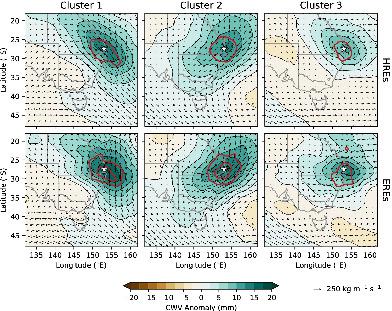当前位置:
X-MOL 学术
›
Q. J. R. Meteorol. Soc.
›
论文详情
Our official English website, www.x-mol.net, welcomes your
feedback! (Note: you will need to create a separate account there.)
Heavy versus extreme rainfall events in southeast Australia
Quarterly Journal of the Royal Meteorological Society ( IF 3.0 ) Pub Date : 2021-07-18 , DOI: 10.1002/qj.4124 Robert A. Warren 1, 2 , Christian Jakob 1, 2 , Stacey M. Hitchcock 2, 3 , Bethan A. White 1, 2
Quarterly Journal of the Royal Meteorological Society ( IF 3.0 ) Pub Date : 2021-07-18 , DOI: 10.1002/qj.4124 Robert A. Warren 1, 2 , Christian Jakob 1, 2 , Stacey M. Hitchcock 2, 3 , Bethan A. White 1, 2
Affiliation

|
Focussing on the major cities of Brisbane, Sydney, and Melbourne in southeast Australia, this study seeks to determine the environmental factors that distinguish between heavy rainfall events (HREs) and extreme rainfall events (EREs). Using daily rain gauge observations, HREs and EREs are defined for each domain based, respectively, on the 95th and 99th percentiles of wet-day rainfall for the period 1979–2018. K-means clustering is applied to mean sea-level pressure, data from ERA5 to obtain a set of representative large-scale circulation patterns associated with these events. Composite synoptic maps, mean vertical profiles, and a series of column-integrated diagnostics are then examined for each cluster and used to compare the environmental characteristics of HREs and EREs. For all three cities, HREs are associated with an upper-level trough to the west, with large-scale ascent, positive column water vapour (CWV) anomalies, and strong moisture transport over the analysis domain. For Brisbane and Sydney, the clusters are characterised by a coastal trough/low with moist onshore flow from the Tasman and Coral Seas. For Melbourne, circulation patterns are more distinct, with clusters characterised by a front, a cut-off low, and an inland trough. Compared with HREs, EREs show a more amplified upper-level trough, with stronger vertical motion and larger CWV anomalies over the analysis domain. In Brisbane and Sydney, EREs also feature stronger and deeper onshore flow, promoting enhanced moisture transport. A diagnostic termed upward vapour transport, which combines the key ingredients of high CWV and large-scale ascent, is shown to discriminate well between HREs and EREs in all three domains. In contrast, surface temperature, which is frequently linked to rainfall extremes via Clausius–Clapeyron scaling, shows significant overlap between the different event categories, particularly for Brisbane and Sydney.
中文翻译:

澳大利亚东南部的强降雨与极端降雨事件
本研究以澳大利亚东南部的布里斯班、悉尼和墨尔本等主要城市为重点,旨在确定区分强降雨事件 (HRE) 和极端降雨事件 (ERE)的环境因素。使用每日雨量计观测,分别基于 1979-2018 年期间湿日降雨量的第 95 个和第 99 个百分位数为每个域定义 HRE 和 ERE。钾-means 聚类应用于平均海平面压力,来自 ERA5 的数据以获得一组与这些事件相关的具有代表性的大规模环流模式。然后对每个集群检查复合天气图、平均垂直剖面和一系列列集成诊断,并用于比较 HRE 和 ERE 的环境特征。对于所有三个城市,HRE 都与西部的上层槽相关,具有大规模上升、正柱水汽 (CWV) 异常和分析域上的强水分输送。对于布里斯班和悉尼,这些集群的特点是沿海槽/低洼处,有来自塔斯曼海和珊瑚海的潮湿陆上水流。对于墨尔本,环流模式更加明显,集群的特征是锋面、截止低压和内陆槽。与 HRE 相比,ERE 显示出更大的上层槽,在分析域上具有更强的垂直运动和更大的 CWV 异常。在布里斯班和悉尼,ERE 还具有更强、更深的陆上水流,促进水分输送。一种称为向上蒸汽传输的诊断方法,结合了高 CWV 和大规模上升的关键因素,可以很好地区分所有三个域中的 HRE 和 ERE。相比之下,经常通过克劳修斯-克拉珀龙标度与极端降雨量相关联的地表温度显示出不同事件类别之间的显着重叠,尤其是布里斯班和悉尼。ERE 还具有更强和更深的陆上水流,促进增强的水分输送。一种称为向上蒸汽传输的诊断方法,结合了高 CWV 和大规模上升的关键因素,可以很好地区分所有三个域中的 HRE 和 ERE。相比之下,经常通过克劳修斯-克拉珀龙标度与极端降雨量相关联的地表温度显示出不同事件类别之间的显着重叠,尤其是布里斯班和悉尼。ERE 还具有更强和更深的陆上水流,促进增强的水分输送。一种称为向上蒸汽传输的诊断方法,结合了高 CWV 和大规模上升的关键因素,可以很好地区分所有三个域中的 HRE 和 ERE。相比之下,经常通过克劳修斯-克拉珀龙标度与极端降雨量相关联的地表温度显示出不同事件类别之间的显着重叠,尤其是布里斯班和悉尼。
更新日期:2021-09-06
中文翻译:

澳大利亚东南部的强降雨与极端降雨事件
本研究以澳大利亚东南部的布里斯班、悉尼和墨尔本等主要城市为重点,旨在确定区分强降雨事件 (HRE) 和极端降雨事件 (ERE)的环境因素。使用每日雨量计观测,分别基于 1979-2018 年期间湿日降雨量的第 95 个和第 99 个百分位数为每个域定义 HRE 和 ERE。钾-means 聚类应用于平均海平面压力,来自 ERA5 的数据以获得一组与这些事件相关的具有代表性的大规模环流模式。然后对每个集群检查复合天气图、平均垂直剖面和一系列列集成诊断,并用于比较 HRE 和 ERE 的环境特征。对于所有三个城市,HRE 都与西部的上层槽相关,具有大规模上升、正柱水汽 (CWV) 异常和分析域上的强水分输送。对于布里斯班和悉尼,这些集群的特点是沿海槽/低洼处,有来自塔斯曼海和珊瑚海的潮湿陆上水流。对于墨尔本,环流模式更加明显,集群的特征是锋面、截止低压和内陆槽。与 HRE 相比,ERE 显示出更大的上层槽,在分析域上具有更强的垂直运动和更大的 CWV 异常。在布里斯班和悉尼,ERE 还具有更强、更深的陆上水流,促进水分输送。一种称为向上蒸汽传输的诊断方法,结合了高 CWV 和大规模上升的关键因素,可以很好地区分所有三个域中的 HRE 和 ERE。相比之下,经常通过克劳修斯-克拉珀龙标度与极端降雨量相关联的地表温度显示出不同事件类别之间的显着重叠,尤其是布里斯班和悉尼。ERE 还具有更强和更深的陆上水流,促进增强的水分输送。一种称为向上蒸汽传输的诊断方法,结合了高 CWV 和大规模上升的关键因素,可以很好地区分所有三个域中的 HRE 和 ERE。相比之下,经常通过克劳修斯-克拉珀龙标度与极端降雨量相关联的地表温度显示出不同事件类别之间的显着重叠,尤其是布里斯班和悉尼。ERE 还具有更强和更深的陆上水流,促进增强的水分输送。一种称为向上蒸汽传输的诊断方法,结合了高 CWV 和大规模上升的关键因素,可以很好地区分所有三个域中的 HRE 和 ERE。相比之下,经常通过克劳修斯-克拉珀龙标度与极端降雨量相关联的地表温度显示出不同事件类别之间的显着重叠,尤其是布里斯班和悉尼。











































 京公网安备 11010802027423号
京公网安备 11010802027423号